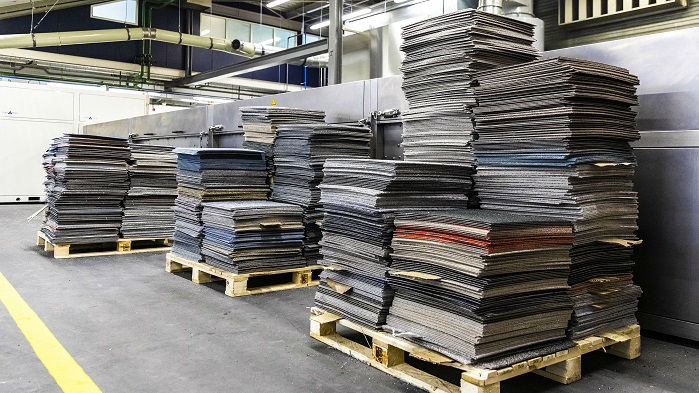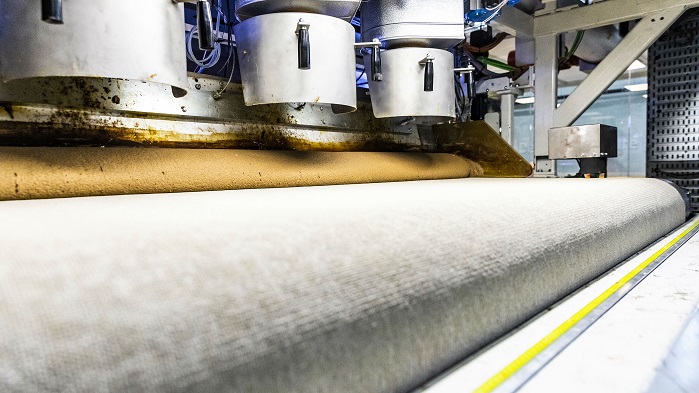
Aquafil to open carpet recycling facility
The two companies presented this significant step towards circular economy at Tarkett’s carpet tile facility in Waalwijk, this week.

22nd November 2019
Innovation in Textiles
|
Ashford/Cartersville, GA
Tarkett is able to separate the two principal components of carpet tiles – yarn and backing. © Tarkett
Tarkett has announced that it is closing the loop on commercial carpet tiles in Europe thanks to a pioneering partnership with Aquafil. This is the result of an intensive collaboration over recent years, going beyond the traditional customer and supplier relationship.
The two companies presented this significant step towards circular economy at Tarkett’s carpet tile facility in Waalwijk, the Netherlands, this week. Its unique recycling centre creates two streams of materials that can be recycled and transformed into high-quality resources for new products.
Tarkett has developed breakthrough technology at its Waalwijk facility and is now able to separate the two principal components of carpet tiles – yarn and backing, while retaining more than 95% yarn purity. This level of purity is vital in ensuring that the polyamide 6 (PA6) yarn can be recycled by Aquafil and later transformed into regenerated Econyl nylon yarn.
In addition, Tarkett has increased its capacity in Waalwijk to produce its EcoBase carpet tile backing to meet customers’ growing demand for this sustainable product. Available since 2010, EcoBase has been designed for disassembly from the outset.

Tarkett’s carpet recycling centre in Waalwijk. © Tarkett
Overall, 100% of an EcoBase-backed carpet tile with PA6 yarn is recyclable. The PA6 yarn and backing are recycled without loss of quality; used yarn becomes new yarn and used backing new backing. Recycling EcoBase-backed carpettiles with Econyl yarn delivers up to 84% CO2 savings compared to incineration.
Tarkett has invested around EUR 15 million on this whole set of initiatives aimed at closing the loop on carpet tiles in Europe. “Technological innovation now makes it possible to multiply the life cycles of building materials. Together with Aquafil, we are accelerating our circular economy journey and leading our industry’s progress in carpet recycling,” said Fabrice BartheÌlemy, Tarkett’s CEO.
“This is a fundamental step forward in maximising the value of materials and preventing carpet tiles from being incinerated or sent to landfill. Truly closing the loop on flooring is a key driver of Tarkett’s strategy to preserve natural resources and protect the environment.”
Giulio Bonazzi, Aquafil’s CEO, comments: “We are delighted to help Tarkett with the last mile of its journey to close the loop on carpet tile production. We must urgently transform the way products are designed, produced and consumed. Through our collaboration with Tarkett, we will strengthen our commitment to realising this vision by increasing the reutilisation of yarns and helping to design out waste.”

Technological innovation now makes it possible to multiply the life cycles of building materials. © Tarkett
Tarkett has sourced PA6 and Econyl nylon yarn from Aquafil for more than a decade and uses Econyl in its Desso AirMaster carpet tiles, for example. Now, the partnership is going full circle, with Aquafil sourcing post-use PA6 yarn from Tarkett to create its regenerated Econyl yarn. “Closing the loop is a collaborative endeavour and we invite our customers to join us in making this journey together through our ReStart flooring take-back and recycling programme,” concludeed Fabrice BartheÌlemy.
“The construction and renovation sector is undergoing a major transformation. Tarkett is playing an active role in this unprecedented mobilization of innovative players committed to reducing the carbon footprint of building materials and to extending their lifespan. In working with us, our customers have the opportunity to make the right choices to create sustainable buildings and spaces for future generations.”

Business intelligence for the fibre, textiles and apparel industries: technologies, innovations, markets, investments, trade policy, sourcing, strategy...
Find out more